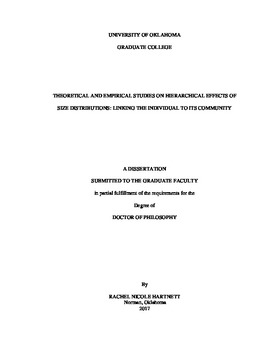| dc.description.abstract | Population and community ecologists often view the world differently based on one assumption: community ecologists often assume that individuals within a population are functionally equivalent; population ecologists focus on these functional differences. The role that individual variation plays in population dynamics has been often overlooked in community and ecosystem ecology, although interest in this area continues to grow.
I focused primarily on how individual variation influences population dynamics and community properties, empirically testing ecological theory and using collected data to inform theory. I used the water flea, Daphnia, as a model organism because they are key primary consumers in aquatic food webs. A number of research groups have gathered valuable physiological data, and recent genomic resources have been developed as well. In addition, much work has been conducted on the important role that daphniids play at both the community and ecosystem level. Further, individual clonal lineages are easily maintained due to their mixed breeding cycles of asexual and sexual reproduction for experimental work. I use a combination of theoretical modeling and empirical testing to address questions at the interface of population and community ecology.
First, in Chapter One, I addressed how the individual phenotype was influenced by genotype and the environment. I wanted to know how sensitive body size was to food quality (i.e., high and low phosphorous content). I conducted a life-history table experiment using three distinct lineages of four species of Daphnia to compare variation in life-history traits among and between species, as well as across two different food quality levels. These data were used to explore the differences in using individual- and biomass-based models that incorporate size-structure information in Chapter Two. I looked into the sensitivity of these types of models to changes in juvenile traits, adult traits, and density-dependence. In Chapter Three, I scaled up from the individual to the population-level, using simple microcosms to address how body size variation contributes to body size distributions. Finally in Chapter Four, I looked at how these species’ variation in traits translated into a more complex environment and within a community context.
Combined, the work presented in my dissertation demonstrates that individual traits and population assemblages influence size-distributions, and trait variation and the standing community influence colonization success. With many communities and ecosystems undergoing rapid environmental changes, linking the role that individual trait variation plays in population dynamics will be key in helping to predict long-term persistence of community (e.g., diversity of heterospecifics) and ecosystem functions (e.g., alternative stable states). | en_US |
